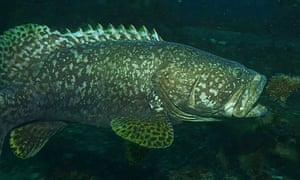https://www.theguardian.com/environment/2018/may/29/new-zealand-marine-heatwave-tropical
New Zealand 'marine heatwave' brings tropical fish from 3,000km away
Out-of-place Queensland groper seen off New Zealand coast after water temperatures soared
Rare tropical fish from Australia have been spotted in New Zealand waters after a record-breaking hot summer and warm ocean temperatures lured the creatures across the Tasman sea.
The Queensland groper, also known as the giant grouper, is the aquatic emblem of the state and was spotted swimming around the wreck of the HMNZ Canterbury in the Bay of Islands on Sunday, more than 3,000 kilometres away from its usual cruising spots on the coral reefs and estuaries off the Queensland coast.
New Zealand experienced its hottest summer on record this year, largely propelled by a “marine heatwave” during which sea temperatures rose as much as six degrees in some areas, and 2-4 in the region where the groper was spotted.
Figures released by the National Institute of Water and Atmospheric Research found the average temperature during January was 20.3C – more than three degrees above normal.
The Queensland groper, a bony fish that can grow up to three metres long and weigh 600kg, is a protected species in Australia, was spotted and recorded by a skipper from Paihia Dive, a small coastal town in the far north of the country.
The fish are known for their curious natures, and often approach divers. Craig Johnston, owner of Paihia Dive, said it was “very rare” to see them, and the odds of their survival were slim once sea temperatures dipped below 18 degrees.
“This is unusual, I’ve been working in the industry 20 years and there hasn’t been a season like this before, it’s quite incredible,”
Johnston said Australian marine life end up in New Zealand when they “hop on” the East Auckland current, which begins life as the East Australian current and runs along the coast before making its way to New Zealand and the Pacific Islands.
The water in New Zealand was generally too cold for the fish to breed, and they would usually die by winter.
Sightings of marine life not usually present in New Zealand waters have been noted around the country this year, including kingfish in Dunedin Harbour, garden eels in the Kermadec Islands (1,000km north of New Zealand), sergeant major damselfish, striated frog fish and Lord Howe Moray in Northland and lion’s mane jellyfish in Wellington Harbour.
The heatwave also led to a boom in land-based animals, including an explosion in the rodent population, which was predicted to increase 10-fold by the spring, due to an abundance in food supply.

沒有留言:
張貼留言